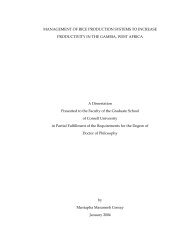Report from SRI China visit - The System of Rice Intensification ...
Report from SRI China visit - The System of Rice Intensification ...
Report from SRI China visit - The System of Rice Intensification ...
Create successful ePaper yourself
Turn your PDF publications into a flip-book with our unique Google optimized e-Paper software.
potential. I did not comment that this is what the <strong>China</strong> National Hybrid <strong>Rice</strong> Center has<br />
concluded, finding yield advantages in managing hybrid rice with <strong>SRI</strong> methods.<br />
Dr. Zhou <strong>from</strong> Guizhou spoke up to say that they see increased yield with less dense planting,<br />
and farmers now agree with this. He said that "if farmers grasp the technology <strong>of</strong> <strong>SRI</strong>, it will be<br />
easy to increase rice yields without requiring more or heavy inputs." I was pleased to hear such a<br />
positive statement based on several years <strong>of</strong> experience with <strong>SRI</strong>. Dr. Ma <strong>from</strong> Sichuan also<br />
spoke up to emphasize the need to achieve food security, as Dr. Zhai has stated. He said he was<br />
confident that this objective could be met with various technologies "like <strong>SRI</strong>," adding that it is<br />
important that the technology be suitable for the environment. This seemed to be an endorsement<br />
<strong>of</strong> <strong>SRI</strong> given what he said about it in his paper.<br />
Someone got up to say that <strong>SRI</strong> cannot increase the number <strong>of</strong> grains produced per square meter,<br />
not just per plant, and this is necessary to get higher yield. He said that he had read this in an<br />
article somewhere (possibly a misunderstanding <strong>of</strong> the article by A. Dobermann in Agricultural<br />
<strong>System</strong>s). In fact, we see such increases with <strong>SRI</strong> in the number <strong>of</strong> grains produced per sq. m. all<br />
the time. Fortunately, there is a growing number <strong>of</strong> Chinese researchers who can deal with such<br />
misstatements <strong>of</strong> fact. At the closing session that day, Dr. Zhai Huqu spoke again on behalf <strong>of</strong><br />
the Chinese Academy <strong>of</strong> Agricultural Sciences. We agreed afterwards that I would <strong>visit</strong> the<br />
Academy next week when I got to Beijing.<br />
<strong>The</strong> day was concluded with a traditional banquet for all the participants with splendid food and<br />
a lot <strong>of</strong> toasting (gambei -- bottoms up) with rice wine and beer, though the drinking was more<br />
restrained than at some banquets I have attended. This group was more interested in karaoke<br />
singing, and it was the most joyous banquet I have participated in, thanks in large part to Pr<strong>of</strong>.<br />
Jin's enthusiasm and congeniality as host. I sat next to Hao Zaibin, who had given an interesting<br />
paper on rice roots the first day, having discovered a mutant rice plant with very different root<br />
configuration, e.g., almost no hair roots. This was permitting him to identify genes that control<br />
certain aspects <strong>of</strong> root development and function. Hao was accompanied by one <strong>of</strong> his students<br />
whose English was better than his so we could have some interesting discussion. He liked the<br />
root pictures in my powerpoint presentation so we exchanged PP files. Having done his PhD<br />
research in Japan, Hao did by far the best karaoke number, in Japanese.<br />
RESULTS IN GUIZHOU PROVINCE: Tuesday morning, participants boarded two buses at<br />
7:30 for a field trip to see some 3-S rice fields. I sat with Dr. Zhou Wei-jia so that I could learn<br />
more about his experience with <strong>SRI</strong> in Guizhou Province. Dr. Lin sat with us to help with<br />
translation. Zhou learned about <strong>SRI</strong> <strong>from</strong> attending our international <strong>SRI</strong> conference held in<br />
Sanya, <strong>China</strong>, in April 2002. I had not gotten acquainted with him or most <strong>of</strong> the 50 Chinese<br />
participants who were hesitant to speak in English. He had taken <strong>SRI</strong> ideas <strong>from</strong> the conference<br />
and applied them in his home province.<br />
When I told him about an e-mail report I received just before coming to <strong>China</strong> -- <strong>from</strong> Nepal, a<br />
mountainous country with similarities to Guizhou, where some <strong>SRI</strong> plants have attained 135<br />
tillers -- Zhou said they have had plants with as many as 110 tillers in Guizhou. He told me that<br />
the record rice yield reported in his paper given on Sunday, 12.9 t/ha, was attained at 1,140<br />
8
















